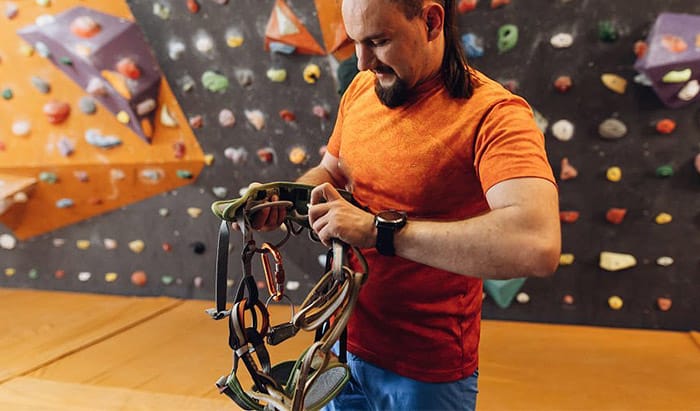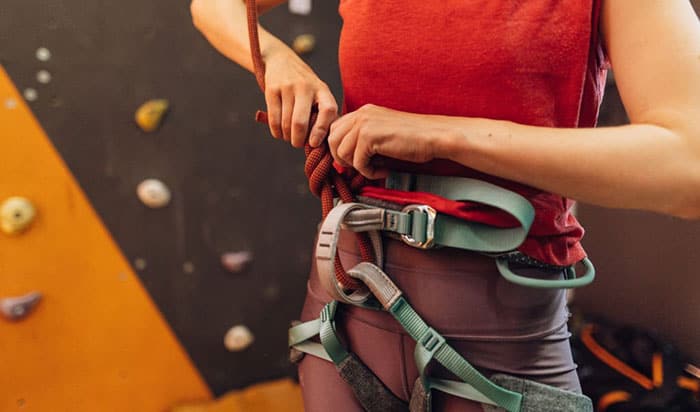An experienced climber knows that the lifespan of a climbing harness is an essential factor to consider when choosing a particular harness brand. While most manufacturers provide an estimated lifespan, the actual longevity of any harness depends on several factors, including the frequency of usage and how the owners take care of and maintain the harness.
So, how long does a climbing harness last? When do harnesses expire? It is difficult to give a definite answer to these questions. But the lifespans of the manufacturer are the basis combined with the other external factors contributing to the harness’s longevity. Please read below:
| Brand Name | Estimated Lifespan After Manufacturing | Estimated Lifespan After First Use |
| Black Diamond | 10 Years | 5 Years |
| Wild Country | 10 Years | 5 years |
| Simond | 10 Years | 5 Years |
| Petzl | 10 Years | Not Indicated |
| Mammut | 10 Years | 7 Years |
As you can see from the samples in the table. The estimated lifespan of a particular harness is 10 years, right after manufacturing. But other brands indicate more years, such as Beal and Rock Empire, which are listing 15 years of lifespan after manufacturing.
On the other hand, the estimated lifespan of a harness after being used is around five years. Although, some brands are listing more like Mammut, which assesses their harness to last for seven years after its first usage. Brands such as Petzl did not indicate an estimated lifespan of their harness after its first usage.
Contents
When to Replace Climbing Harness
When you talk about the number of years that a climbing harness lasts, it is also imperative to know the right time to say goodbye to your harness and replace it with a new one. Of course, the attachment and the bond created between you and the climbing harness over the years together is something special.
However, the time will come when the harness does not perform as expected and cannot protect you anymore, which means replacing it is the best thing to do. Saying goodbye to your reliable harness is hard, but it must be done even with the cost for your safety.
Knowing when to say google to your harness is essential. But there are no rules on when to do it. But since you are the owner and your safety relies on the harness, it is necessary to know some visual indicators that say it is now time to retire your climbing harness.
Physical Indicators to Retire the Climbing Harness
One way to know when to retire a climbing harness is to know its current physical condition. If you find discoloration on any part of the climbing harness, that is a sure sign that the climbing harness is already old.
Also, when some features are unstitched, or the safety stitchings are already damaged, these two conditions are indicators to say goodbye to your harness. Another indicator is when the belay loop and tie-in point are worn out is any visible wear on any part of the harness.
In addition, when you find the webbing cut, torn, or damaged, it should help you decide to replace the harness as soon as possible. When you find the buckles already damaged, you need to replace the harness immediately for your safety.
Invisible Indicators
There are also invisible indicators that you need to consider to determine the right time to replace your climbing harness. One obvious indicator is the age of the harness. If it is already with you for more than the estimated lifespan that the manufacturer indicates, then it is now time to say goodbye to your harness.
Another invisible indicator is the amount of force it handles throughout the years, which you should know because you have been using it since day one. If you feel it has already dealt with a significant amount of force, then replacing the harness is the best thing to do.
Lastly, suppose you think that the climbing harness has been improperly stored or not adequately maintained by you, and it has also shown other indicators stated above. In that case, the best thing to do is replace the harness immediately for your safety.
Other Factors to Consider
The usage frequency of the climbing harness is also another factor to consider when deciding to replace it. For example, if you just store the harness and never use it, it should last, as the manufacturer indicates, around 10 to 15 years, based on the table above.
If you use it only once, it will last the same number of years. A harness used once a month can probably last for five years, while those used every week can last up to three years. If you are an active climber and use the harness daily, you should replace it after a year.
Always remember that if you do not trust the harness or have lost confidence in it, it is better to give it a go. Many things can happen when you climb, so having a harness that is well-conditioned and has the ability to protect you is a must.
Conclusion
Knowing how long does a climbing harness last cannot be answered directly. It involves a lot of factors, as stated in this article. Most brands say the harness can last ten years after manufacture or five years after its first usage. However, these estimates can increase or decrease depending on various factors, including the frequency of use and your ability to maintain the harness.


